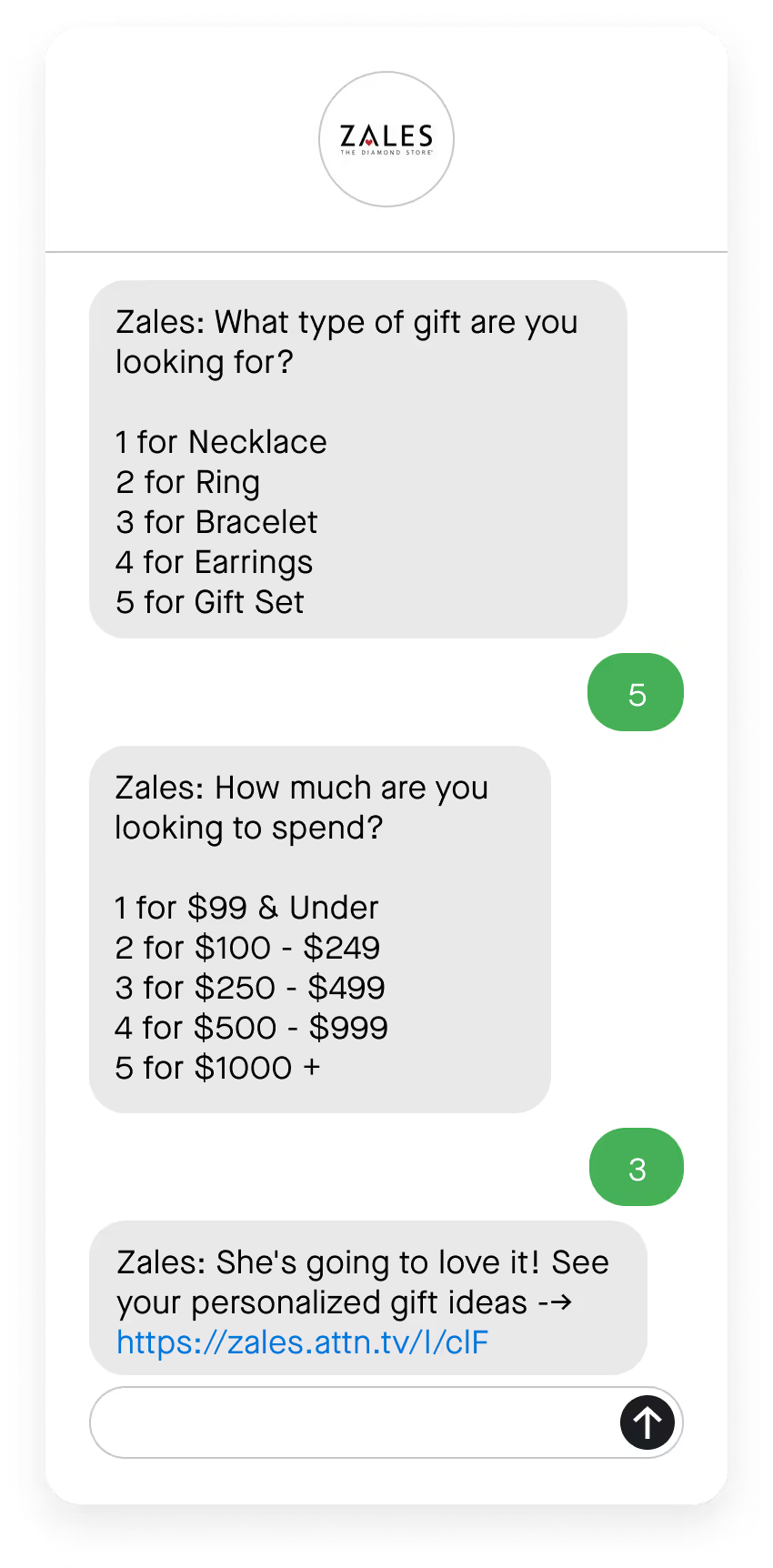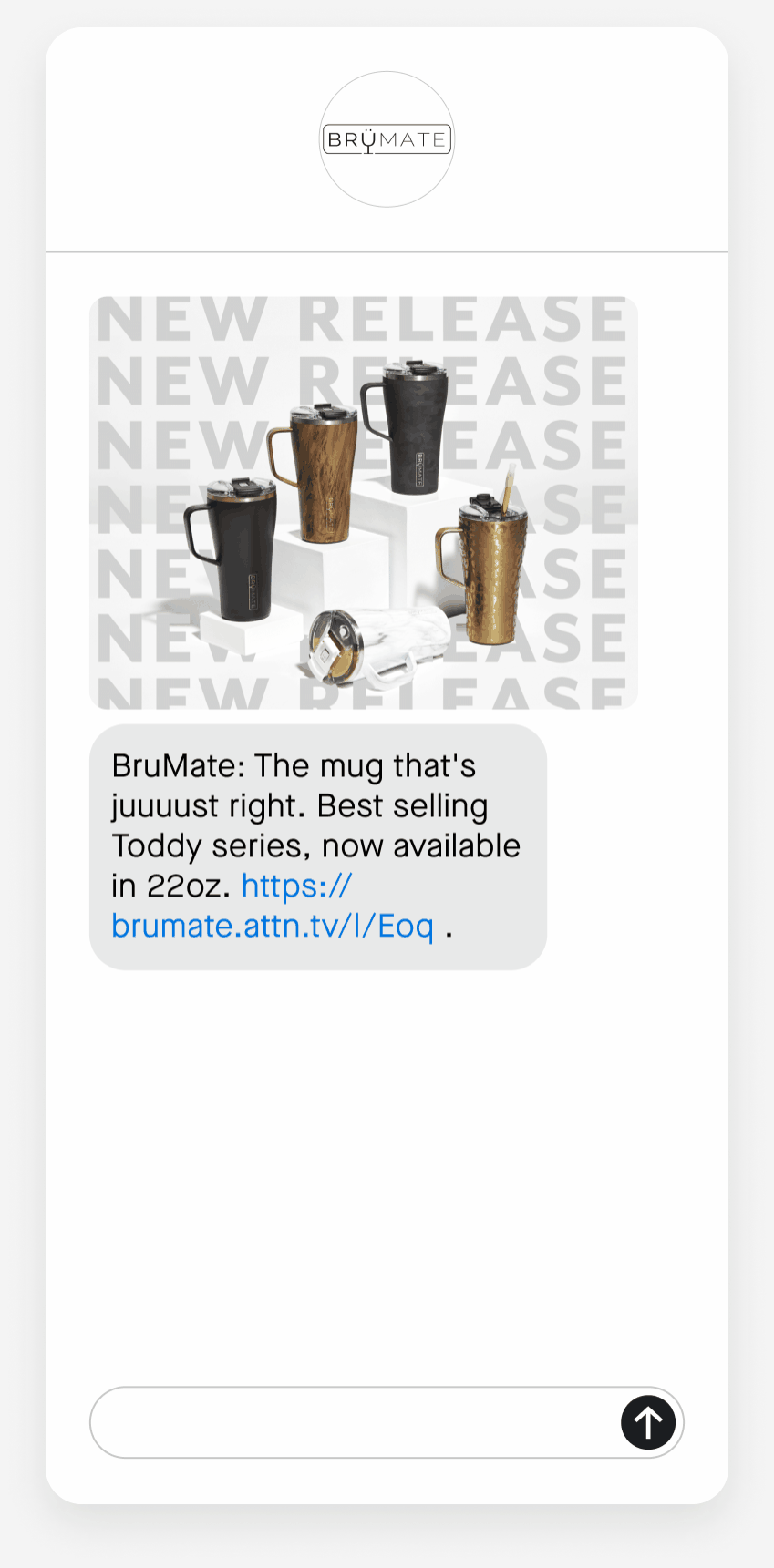
New releases
A smarter, simpler Attentive
Explore new features →
Explore new features →
Elevate your marketing with real-time, AI-powered data activation
Build and scale with unparalleled guidance and support

Engage customers with text messages that drive loyalty and revenue
Boost revenue and save time with personalized emails that convert
Turn every text into a branded, media-rich conversation

Create and send top-performing campaigns in a fraction of the time
Automatically analyze every customer interaction, behavior, and data point

Collect SMS and Email subscribers quickly with easy sign-up units
Connect seamlessly with flexible integrations that drive growth
Identify, understand, and engage more website visitors
Send messages knowing they’ll be delivered, even during peak periods

30X total AI program ROI
30X total SMS program ROI
192% boost in email revenue
28X program ROI
40% revenue increase from emails
48X ROI on gifting recommendations
$4.5M SMS-attributable revenue
88X welcome journey ROI

Guides, reports, videos, and more to help you build and grow your program
Strategies, trends, and insights to help you become an industry expert
Quick tips, tutorials, and insights to maximize your program's potential
Live and on-demand recordings to keep learning

Explore proven strategies and results from innovative brands
Real SMS examples to inspire your next campaign
Top marketing tips and strategies for key dates in 2025
Instantly calculate your projected revenue and subscriber growth

Check out our how-to guides, webinars, and more
Enlist the expert guidance of an Attentive agency partner
APIs for subscription, messaging, and custom integration needs
Elevate your marketing with real-time, AI-powered data activation
Identify, understand, and engage more website visitors
Send messages knowing they’ll be delivered, even during peak periods
Build and scale with unparalleled guidance and support
Run your program with tools designed to protect you from potential risk
Connect seamlessly with flexible integrations that drive growth

Engage customers with text messages that drive loyalty and revenue
Boost revenue and save time with personalized emails that convert
Turn every text into a branded, media-rich conversation

Create and send top-performing campaigns in a fraction of the time
Automatically analyze every customer interaction, behavior, and data point

Collect SMS and Email subscribers quickly with easy sign-up units
Connect seamlessly with flexible integrations that drive growth
Identify, understand, and engage more website visitors
Send messages knowing they’ll be delivered, even during peak periods
Make data-driven decisions with detailed, customizable reports
Run your program with tools designed to protect you from potential risk
Reach the right audiences with precise targeting and dynamic segmentation

30X total AI program ROI
30X total SMS program ROI
192% boost in email revenue
28X Program ROI
40% revenue increase from emails
48X ROI on gifting recommendations
$4.5M SMS-attributable revenue
88X Welcome Journey ROI

Real SMS examples to inspire your next campaign
Proven strategies and results from leading brands
See how our customers turn personalized interactions into revenue

Engage customers with messages that drive loyalty and revenue
Boost revenue and save time with personalized emails that convert
Instantly connect with your audience in real time to drive more revenue
Reach more customers, drive loyalty, and boost revenue with SMS and email
Engage more customers and boost bookings with personalized messages

Exceed growth goals with guidance from our agency partners
Unlock features, personalization, and data with flexible APIs
Deliver the right messages to the right customers across 20+ companies

Guides, reports, videos, and more to help you build and grow your program
Strategies, trends, and insights to help you become an industry expert
Quick tips, tutorials, and insights to maximize your program's potential
Live and on-demand recordings to keep learning
Text messaging industry insights to help you become an SMS expert
Learn how to deliver the personalized experiences consumers want

Explore proven strategies and results from innovative brands
Real SMS examples to inspire your next campaign
Top marketing tips and strategies for key dates in 2024
Instantly calculate your projected revenue and subscriber growth

Check out our how-to guides, webinars, and more
Enlist the expert guidance of an Attentive agency partner
APIs for subscription, messaging, and custom integration needs

Elevate customer engagement with rich RCS messaging features
Get the latest on new products, features, and enhancements
Take a video tour of our platform







Bohemian apparel brand Free People acquires new text and email subscribers through Attentive’s 2-in-1 sign-up solution. By offering free shipping, shoppers are even more incentivized to opt in. Once the shopper inputs their email address, they are prompted to complete their sign up and receive the free shipping reward by also opting in for text messages. This marketing strategy is a powerful tool for brands to rapidly grow both email and text messaging subscribers.

Footwear and fashion accessories retailer Steve Madden sent a text message to subscribers alerting them of a “must-have” item. The brand used a sense of urgency in the copy (“selling out fast” and “before it’s gone”) to encourage subscribers to purchase the wardrobe staple. Steve Madden kept the message short and ended with a direct link to immediately shop the item. By emphasizing a popular item, subscribers feel like they’re staying on top of the latest footwear trends.

Intimates apparel brand Knix texted subscribers about their new, limited-edition product launch. The brand included a GIF that offered a sneak peek of the new loungewear, and they ended the text message with a direct link to shop the new line. Including a sneak peek of the “comfy, cozy and cuddly” new line, and highlighting the limited edition nature of the product, excites subscribers and encourages them to be the first to shop the new collection.

Zales recommends personalized gift ideas to new subscribers using Attentive’s Two-Way Journeys™. This conversational strategy helps Zales drive online revenue by imitating their in-store product discovery experience. They can also add these preferences as “custom attributes” to each subscriber’s profile, helping them deliver relevant messaging throughout the entire customer lifecycle.

bioClarity invited subscribers to glow into the new year with a refreshed skincare routine. The seasonal discount code only applied to first-time purchasers of their auto-ship routine service. This subscription-style offer reassured customers they won't run out of their favorites, while encouraging repeat purchases.

Inkbox inspired their SMS subscribers’ new year looks with a direct link to their style guide. To avoid fatiguing subscribers, Inkbox excluded customer segments that hadn't purchased or clicked on text messages in the last few months.

Lifestyle retailer Urban Outfitters sent a “deal of the day” text message offering 50% off hundreds of styles. They included a custom GIF that boldly stated the deal, along with the brand’s logo in the form of a smiley face and a bright yellow ticket that says “today only.” The copywriting in the message (“nbd”) perfectly embodies the fun voice of Urban Outfitters. And, this campaign suggests there will be more daily deals, encouraging repeat browsing while building brand loyalty.

Function of Beauty knew they needed to offer something special to compete with Amazon's Prime Day deals and capture shoppers' attention. The brand launched a playful campaign to give their customers “prime” treatment—the chance to get 20% off their entire order for three days only. By aligning their sale period with Prime Day but extending it an extra 24 hours, Function of Beauty was able to get the most out of the shopping holiday and maximize their revenue.

BrüMate used SMS to introduce a new version of their best-selling mug. They targeted the message to their high-interest subscriber segment—those who had added products from the Toddy collection to their cart, but hadn’t recently made a purchase. These engaged subscribers were quick to click the direct link and claim the best seller. Click below to see our BrüMate Toddy in the Attentive Goods store.

Let’s give this another spin: try selecting different filters.

